Coastal erosion: The 'forgotten' community left to fall off a cliff
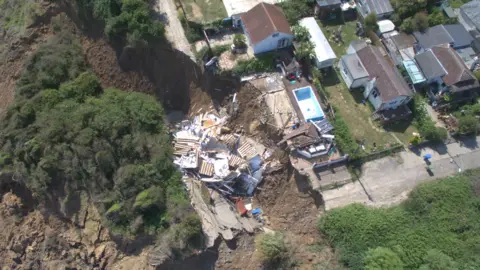 RLH Media
RLH MediaEmma Tullett was sitting on the sofa scrolling through YouTube music videos when her home began to fall apart.
A window blind came crashing down and as her partner tried to reattach the fitting, he saw a row of trees slowly sliding over the nearby cliff edge.
"He said 'you need to get out' and I think that's when I just lost it a little bit," the 42-year-old said.
She gathered up her four children, throwing coats over the youngest, aged six and eight. In the dash for safety, she didn't even have time to put on their shoes.
Over the next four days, she watched from a distance as her home on the Isle of Sheppey, Kent, went over the cliff in stages. The slow process was "like torture", she said, and left a strange sense of "relief" when the whole thing finally fell on 2 June.
"I've got nothing," she said. "All we got out with was the pyjamas we were wearing."

Across England in the next decade, it is estimated that up to 2,000 homes could face a similar fate due to coastal erosion, which is expected to accelerate with climate change.
Thousands more properties have been protected by costly coastal defences.
So, why are some areas saved and others left to fall into the sea?
Like other small communities nationwide, Ms Tullett and her neighbours on the Isle of Sheppey have been told that, simply put, their homes are not worth saving.
The island's relatively soft cliffs, made mainly of London Clay, have for centuries been slipping into the Thames Estuary, exposing internationally renowned fossil deposits.
On the north of the island, 124 homes and 1,000 caravans along a four-mile (6.6km) stretch are thought to be at risk in the next century. It would cost more than £25m to protect them all, engineers employed by Swale Borough Council found.
With this in mind, the council and the Environment Agency - which are jointly responsible for managing coastal defences in the area - agreed on a policy of "no active intervention". Nature would be left to run its course.
"The financial value of the area at risk does not outweigh the costs to build and maintain the measures required," residents were told in a letter from the Department for Environment, Food and Rural Affairs.
Coastal defences, such as building a wall of rock to stop waves lapping at a cliff's base, are expensive and can have unintended consequences, like hastening erosion elsewhere, said landslide expert Dave Petley, a professor at the University of Sheffield.
"For smaller communities in general, it's not considered to be worth the damage to the adjacent sections of the cliff or the damage to the environment," he added.

Ms Tullett made an offer less than an hour after viewing her dream home. The property, called Cliff Hanger, had stunning views and ample space for her children.
She paid in cash in August 2018, believing the family would have decades before they need worry about the encroaching cliffs.
Erosion is a gradual process, she thought, and by the time her home was at risk "they'd probably have dumped me in a nursing home".
Her neighbour Malcolm Newell moved to Surf Crescent with his wife in 2001, hoping to escape the "hustle and bustle" of the mainland.
The retired wood-turner, 71, said they had enjoyed "16 good years" before his wife died. "The memories that are here can't be replaced," he said.
But, by 2015 he had become increasingly concerned about his future and began campaigning for action to halt erosion.

The battle has seen him elected to Eastchurch Parish Council and come up against an array of public bodies, including the Environment Agency, Natural England and Swale Borough Council.
He is left feeling that he and his neighbours are the "outcasts of the island", and says: "We are the forgotten few."
The 30 or so homes, nestled between two caravan parks, are connected by several unsurfaced, rutted roads.
Mr Newell believes the rugged appearance means they are written off by the authorities. "We get looked on as if we are hillbillies," he said.
In 2016, his campaign won a small victory, persuading the council to invest £30,000 in biodegradable matting that it was tentatively hoped might slow erosion. The work also required permission from Natural England, which has protected the cliffs as a Site of Special Scientific Interest, to allow the study of the landslides themselves.
Sheppey MP Gordon Henderson told Parliament in 2017, it was "scandalous" that "in Natural England's eyes, fossils and slumping clay are more important than the homes and livelihoods of my constituents".
 St Paul's Cathedral/YouTube
St Paul's Cathedral/YouTubeMr Henderson admitted that there was a "Wild West-type environment" among some on the island, who preferred to be free from outside intervention.
"That doesn't detract from the services we should be providing those people and the protection that they deserve and they should be getting," he told the BBC.
Less than 40 miles away, the East Sussex village of Fairlight provides a very different story.
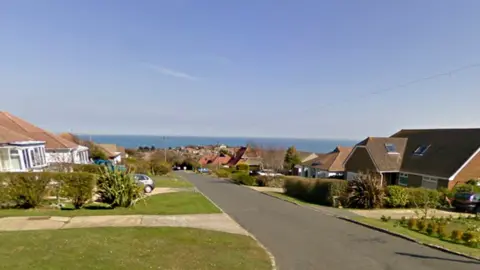 Google
GoogleBy the late 1980s, several homes in Fairlight Cove had already been lost to the sea and up to 200 more were at risk.
Like residents of Surf Crescent, villagers had been told coastal defences would be too expensive, after research for Rother District Council concluded the costs of the works would exceed any benefits.
However, local resident Dr Ruth Kosmin, a government economist who was "familiar with how to do a cost-benefit analysis", took a second look at the numbers and found they were "completely out and that actually the benefits outweighed costs".
Armed with this information, the residents' group - now a registered charity called the Fairlight Preservation Trust - persuaded the district council to submit an application for government funding, and a rock berm costing £2.7m was installed in 1990.
In the following 25 years, the community twice bid successfully for additional defences, with a second berm installed at a cost of £2.7m in 2007. By the time a third application was made in 2015, the government required "partnership funding" and residents contributed £150,000 towards the £1.7m costs - of which £75,000 was paid by the Fairlight Parish Council.
Alongside personal donations, residents "did everything from cream teas, to cycle events" to raise the money, Dr Kosmin said.
 Laurie Beetham
Laurie BeethamLooking back on the decades-long fight to protect their homes, Dr Kosmin said the professional expertise of local residents was "absolutely crucial" to their success.
"We had local lawyers, we had people who were company secretaries, we had people in business, we knew how to deal with government," she said.
But, Dr Kosmin believes other communities who lack the same expertise would not be at a disadvantage, because in most cases the local authority would champion their cause and hire expert consultants.
Any intervention now would be too late for Ms Tullett and her family, whose future remains uncertain.
Decades spent climbing the property ladder have been for nothing. "We're back to square one," she said.
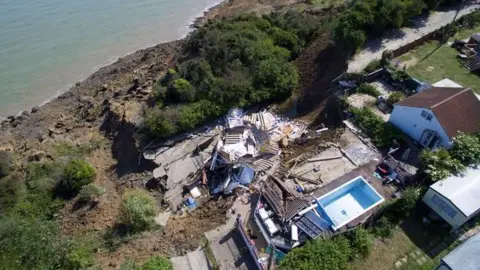 RLH Media
RLH MediaMs Tullett, who manages a grocery store in Minster, Kent, had owned her home outright, but with no prospect of an insurance payout, she now faces monthly rent bills.
She wonders why homes can still be bought and sold in the area if the authorities know it "could go at any minute".
"Why not compulsory-purchase all the property? Just say... you're not living here any more."
Prof Petley believes many homeowners "genuinely haven't understood the risk that they're taking" buying a cliff-top property.
A "high burden" is placed on householders' ability to understand "whether that house is at risk or not", he said.
You might also be interested in:
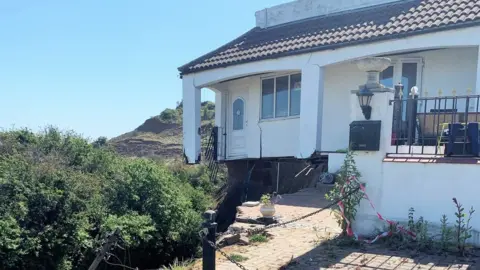 KFRS
KFRS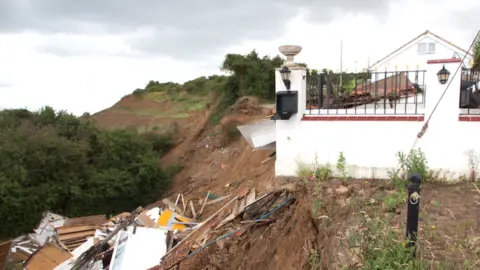
The government has pledged to spend £5.2bn over the next six years to protect households at risk of coastal erosion and flooding.
But, in areas that don't qualify for publicly funded coastal defences, local councils are responsible for helping people to adapt to the growing threat.
While government grants of £6,000 are available to demolish at-risk homes, any other financial support is limited and varies from area to area.
"The prevailing view, and I do think this is harsh, is you need to recognise that the cliff will retreat towards your house and eventually it will imperil it," Prof Petley said.

Asked what had been done to inform residents of the risk and help them adapt, Swale Borough Council said erosion had been a "well-known issue along this stretch of coast for decades", adding that it would be "highlighted in surveys when someone buys a property or takes out home insurance".
It added that it had held a public exhibition in 2013, which "explained the justification for the no active intervention policy".
Prof Petley believes a national fund - similar to New Zealand's earthquake commission - is needed to compensate homeowners like Ms Tullett and help others move out of harm's way.
"As a country, we've made a decision that we don't support people in that position," he said. "If your house is destroyed by coastal erosion or by landsliding, essentially you're on your own."
